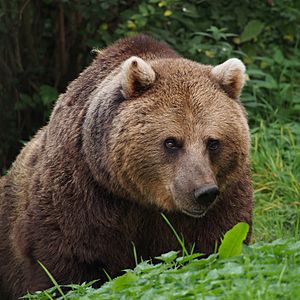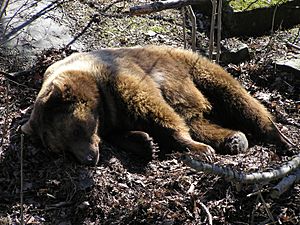Eurasian brown bear facts for kids
Quick facts for kids Eurasian brown bear |
|
|---|---|
 |
|
| Conservation status | |
| Scientific classification |
|
| Kingdom: | Animalia |
| Phylum: | Chordata |
| Class: | Mammalia |
| Order: | Carnivora |
| Family: | Ursidae |
| Genus: | Ursus |
| Species: | |
| Subspecies: |
U. a. arctos
|
| Trinomial name | |
| Ursus arctos arctos Linnaeus, 1758
|
|
The Eurasian brown bear (Ursus arctos arctos) is a type of brown bear found across much of Eurasia. It is one of the most common kinds of brown bears. People also call it the European brown bear or common brown bear.
Scientists study the genes of brown bears to understand how they are related. They have found that brown bears around the world can be grouped into five main families based on their DNA.
Contents
What Does the Eurasian Brown Bear Look Like?
Eurasian brown bears have brown fur. Their fur can be light yellowish-brown, dark brown, or even reddish-brown. Sometimes, their fur can look almost black. Very rarely, a bear might even be albino (all white).
Their fur is thick, and the hairs can grow up to 10 centimeters (about 4 inches) long. They have a round head with small, rounded ears and a wide skull. Inside their mouth, they have 42 teeth, including strong teeth for eating.
These bears have a powerful body and large paws. Their claws can grow up to 10 centimeters (about 4 inches) long. How much a bear weighs depends on where it lives and the time of year.
- A full-grown male bear usually weighs between 250 and 300 kilograms (550 to 660 pounds).
- The heaviest male ever recorded weighed 481 kilograms (1,058 pounds) and was almost 2.5 meters (8.2 feet) long!
- Female bears are smaller, usually weighing between 150 and 250 kilograms (330 to 550 pounds).
In the wild, these bears can live for 20 to 30 years.
History of the Eurasian Brown Bear
Brown bears used to live in Britain, but they were hunted until they disappeared by the year 1000 AD.
In Ancient Rome, Eurasian brown bears were used in arenas for fighting. The strongest bears were thought to come from areas like Caledonia (which is now Scotland) and Dalmatia (part of modern-day Croatia).
Long ago, Eurasian brown bears ate mostly meat. About 80% of their diet was animal matter. But as their homes became smaller, they ate less meat. By the late Middle Ages, only 40% of their diet was meat. Today, meat makes up only about 10–15% of what they eat. If they can, brown bears will sometimes eat sheep.
In Scandinavia, there have been very few serious incidents involving bears in the last 100 years. However, in some other areas, like Romania and Belarus, there have been reports of bears causing harm to people.
Where Did Brown Bears Come From?
The oldest brown bear fossils found are from China and are about 500,000 years old. During the Pleistocene ice age, it was too cold for brown bears to live in most of Europe. They could only survive in a few places: Russia, Spain, and the Balkans.
Scientists have studied the DNA of brown bears to learn about their family tree. They found that the brown bear species started more than 500,000 years ago. The Eurasian brown bear group separated from other brown bears about 850,000 years ago. One group settled in Western Europe, and another group spread across Western Europe, Russia, Eastern Europe, and Asia.
Further studies show that the European brown bear family split into two main groups. One group lives in the Iberian Peninsula (Spain and Portugal) and the Balkans. The other group lives in Russia.
In Scandinavia, there are bears from both the western and eastern family lines. Bears in southern Scandinavia likely came from populations in the Pyrenees mountains (between Spain and France) and the Cantabrian Mountains in Spain. These bears moved north after the last ice age. Bears in northern Scandinavia probably came from populations in Finland and Russia. Their ancestors likely survived the ice age in areas west of the Ural Mountains that were not covered in ice.
Where Do Eurasian Brown Bears Live Today?
Brown bears once lived across almost all of Eurasia. Today, their living areas are much smaller.
The brown bear species as a whole is listed as "Least Concern" by the IUCN Red List of Threatened Species. This means they are not currently in danger of disappearing globally. However, it's important to know that this doesn't mean all local groups of bears are safe. Some local populations are becoming very rare. The IUCN warns that "Least Concern does not always mean that species are not at risk."
Brown bears are no longer found in Ireland and Britain. But they still live in Northern Europe and Russia.
- There is a small but growing group of at least 43 bears in the Pyrenees mountains, on the border of Spain and France. This group was once almost gone.
- In the Cantabrian Mountains in Spain, there are about 250 bears in two groups.
- Italy has about 100 bears in the Abruzzo, South Tyrol, and Trentino regions.
In Baltoscandia (around the Baltic Sea), bear numbers are slowly going up:
- Sweden has almost 3,000 bears.
- Finland has about 2,000 bears.
- Estonia has 1,000 bears.
- Norway has about 100 bears.
Large numbers of bears can also be found in:
- Romania (around 6,000 bears)
- Slovakia (around 1,200 bears)
- Bosnia and Herzegovina
- Croatia (1,200 bears)
- Slovenia (500-700 bears)
- North Macedonia
- Bulgaria
- Poland
- Turkey
- Georgia
Smaller but still important groups live in Albania, Greece, Serbia, and Montenegro. In 2005, there were about 200 bears in Ukraine. These bears are part of two larger groups: the Carpathian group (over 5,000 bears) and the Dinaric-Pindos group (around 3,000 bears).
The biggest brown bear population in Europe is in Russia. Their numbers have grown back after being very low due to too much hunting. Globally, the largest group of brown bears lives east of the Ural Mountains, in the huge forests of Siberia. Brown bears also live in smaller numbers in parts of Central Asia (former Soviet countries).
Other types of brown bears live in small, separate groups in Iran, Afghanistan, Pakistan, parts of northwest India, central China, and on the island of Hokkaido in Japan. Many of these groups are highly threatened.
Bears in Culture
Bears have been important to people for a long time. You can see this in the names of many places and people.
- Some places named after bears include Berlin, Bern, Medvednica, Otepää, and Ayu-Dag.
- Many personal names also come from bears, such as Xiong, Bernard, Arthur, Ursula, Urs, Ursicinus, Orsolya, Björn, Nedved, Medvedev, and Otso.
Eurasian brown bears often appear in European fairy tales and fables. The famous stories collected by Jakob and Wilhelm Grimm often feature them. Since these bears were once common in Germany and alpine areas like Northern Italy, Eastern France, and Switzerland, they show up in many German tales.
The bear is a traditional symbol of Russian strength. It is also the national animal of Finland. In Croatia, a brown bear is shown on the back of the 5 kuna coin, which has been made since 1993.
Images for kids
See also
 In Spanish: Oso pardo europeo para niños
In Spanish: Oso pardo europeo para niños






